Aseptic Packaging Market Size
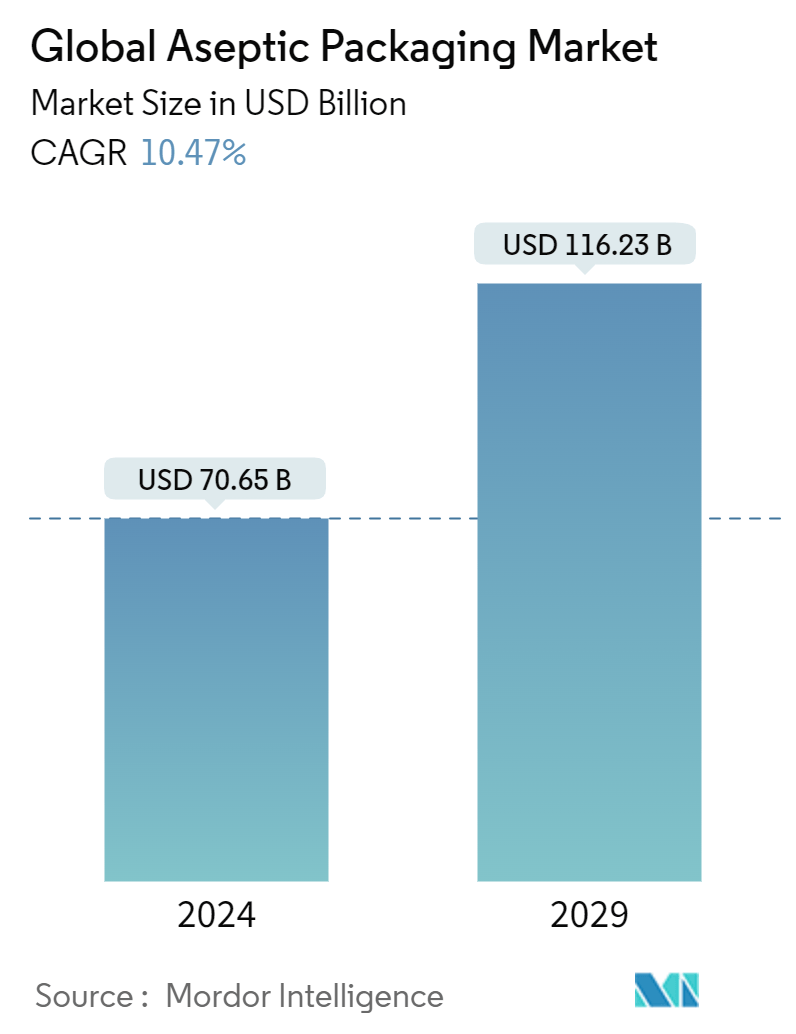
| Study Period | 2019 - 2029 |
| Market Size (2024) | USD 70.65 Billion |
| Market Size (2029) | USD 116.23 Billion |
| CAGR (2024 - 2029) | 10.47 % |
| Fastest Growing Market | Asia Pacific |
| Largest Market | Asia Pacific |
Major Players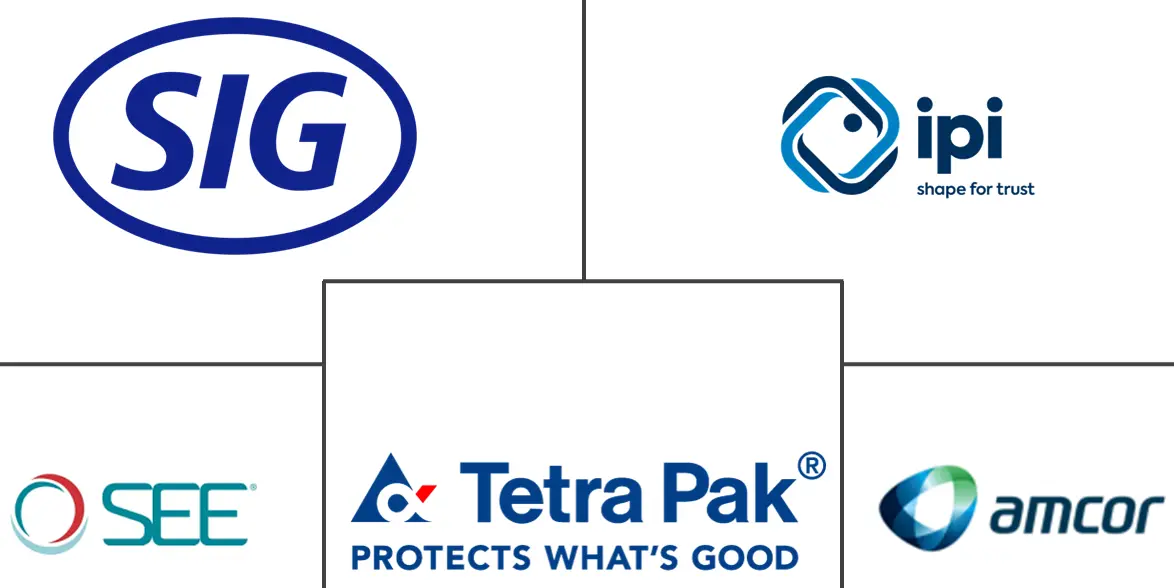
*Disclaimer: Major Players sorted in no particular order |
Need a report that reflects how COVID-19 has impacted this market and its growth?
Aseptic Packaging Market Analysis
The Global Aseptic Packaging Market size is estimated at USD 70.65 billion in 2024, and is expected to reach USD 116.23 billion by 2029, growing at a CAGR of 10.47% during the forecast period (2024-2029).
- Aseptic packaging involves packaging a product at ultra-high temperature (UHT), sterilizing or sanitizing the packaging separately, and fusing and sealing under sterile atmospheric conditions to avoid viral and bacterial contamination. In addition, it maintains the quality of the package contents and does not require preservatives.
- Sustainable packaging and longer shelf life are essential to consumers in the food and beverage industry. As a result, most food and beverage vendors are inclining toward aseptic packaging due to its cost and environmental benefits. Also, as aseptic packaging supports packaging through recyclable cartons and eco-friendly pouches and bags, which often target consumers that prefer small-quantity packaging and make purchases more frequently, the demand for such products is considerably high worldwide.
- Changing consumer eating habits is increasing the preference for ready-to-eat meals and demand for convenient, high-quality food products, opening more doors for market growth. A gradual increase in global e-commerce sales and growth opportunities in emerging markets is anticipated to present significant opportunities for the sterile packaging market during the forecast period.
- The pharmaceutical industry utilizes aseptic pouches for packaging liquid medications, IV drugs, and other sterile products. Factors driving the growth of the aseptic packaging market include a rising need for biologics and vaccines. The demand is primarily due to the requirement for maintaining sterility and extending shelf life.
- The surge in mergers and acquisitions within the aseptic packaging market signals the strategies of market players to consolidate and capitalize on evolving consumer demands for safe and convenient packaging solutions. For instance, in October 2023, Shandong NewJF Technology Packaging Co. Ltd (NEWJF), a Chinese aseptic packaging enterprise, completed the acquisition of a 28.22% stake in Greatview Aseptic Packaging. This was intended to elevate NEWJF's position in liquid product packaging by enhancing market presence, streamlining operations, and fostering innovations in the rapidly growing market.
Aseptic Packaging Market Trends
The Growing Demand for Beverages is Expected to Drive the Market
- The rising consumption of on-the-go beverages and the increasing number of outlets are expected to boost the market's growth in the beverage industry. The change in consumer needs provides packaging producers with several options for meeting innovative packaging needs in the beverage industry.
- Consumers frequently grab convenient and functional drinks, such as RTD coffee and tea, energy drinks, and other beverages that can be consumed whenever and wherever they need a boost. Non-alcoholic drinks that offer functional and practical benefits that are relatively healthy and natural can appeal to busy consumers. Leveraging the natural, energy-boosting characteristics of electrolytes, vitamins, minerals, and other natural ingredients in new product formulations can help brands target a specific consumer base.
- The increasing demand for nutraceutical beverages and products due to several healthy ingredients, such as vegetables and fruits, and the rising global demand for milk-based drinks are expected to boost global functional growth. This is expected to be a significant growth driver for the beverage market during the forecast period.
- The increasing demand for instant energy drinks that provide mental and physical stimulation among fitness enthusiasts is projected to create significant growth opportunities for the functional beverage market during the forecast period.
- Consumers in the market are becoming increasingly conscious of health and wellness. From juice in the morning to energy drinks, they are spending more on products that provide refreshments and are well within the wellness trend. This trend has created a high demand for cost-effective packaging solutions in the beverage packaging segment. The increasing demand for aseptic cartons from the milk and other dairy beverages sectors may trigger additional activity in the market due to the ability of cartons to offer benefits like easy stacking of products and longer shelf life.
- As per data from Statistisches Bundesamt; BMEL, Germany's high per capita milk consumption in 2023 at 44.38 kg indicated a strong demand for dairy products, driving the adoption of aseptic packaging solutions to maintain product freshness and extend shelf life, which aligned with consumer preferences for convenience and food safety.
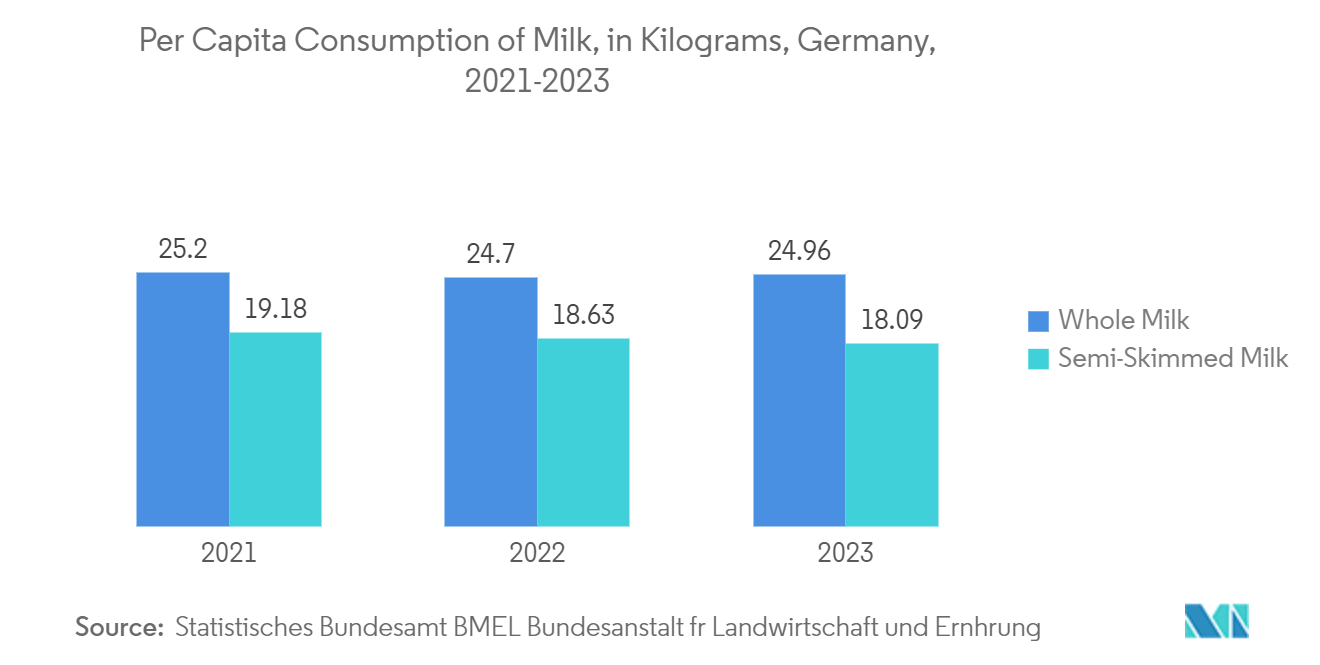
Asia-Pacific is Expected to Witness the Fastest Growth
- China is one of the major consumers of aseptic packaging in Asia-Pacific. The growing food and beverage sector is anticipated to support the market's growth during the forecast period. The growing trend of packed meals, the increasing number of restaurants and supermarkets, and the increasing consumption of bottled water and beverages are significant factors driving the market in the country.
- In October 2023, Chinese food company Hainan Chunguang Foodstuff Co. selected Sidel's Aseptic Combi Predis line to expand into the beverage market by producing coconut milk. Utilizing Sidel's PET design for 350 ml bottles, the latest facility produces 28,000 bottles per hour. This installation supplements the existing more than 100 aseptic line setups across China. The adoption of Sidel's technology by Hainan Chunguang contributed to the growth of the aseptic packaging market.
- Consumers increasingly use aseptic pouches in Japan, particularly for sauces and curries. Aseptic pouches can replace conventional cans since they are made from laminated plastic and aluminum, which can withstand the thermal processing used for sterilizing. Pouch packaging is more affordable than cans, especially in nations that import metal for canning, which is the key driver promoting acceptance in Japan. The rising consumption of soft drinks is also leading to the expansion of aseptic production lines among beverage manufacturers. For instance, in February 2023, Coca-Cola Japan built an aseptic production line for its coffee products at its Ebina plant.
- Australia is one of the Asia-Pacific region's fastest-growing packaging markets. The meat, fresh produce, and processed food industries are growing nationwide. Rising consumer ethical concerns and trends in health and well-being have sustained the demand for locally produced, fresh food. In addition, the use of single-serve and reusable packaging options such as pouches has increased along with the country's tendency to snack over the years. The demand for RTD pouches is also fueled by the steadily rising demand for dairy products and fresh fruit juices.
- India's market is driven by a growing population, increased income, and changing lifestyles. Growth prospects of end-user segments are leading to a rise in the demand for the rigid plastic packaging industry. In addition, the market's expansion products are being constrained by the increasing use of alternative packaging options for pouch packaging. Due to the rapidly growing demand for packaged food goods and increased disposable income, India is expected to hold a significant share of the Asia-Pacific aseptic packing market.
- As per the USDA Foreign Agricultural Service, in 2023, the consumption in India was 207.5 million metric tons, indicating a steady annual growth of 2.5%. India's substantial milk consumption rates prompt a surge in aseptic packaging adoption, catering to the growing demand for convenient, longer-lasting dairy products while addressing logistical challenges in distribution and storage, fostering market growth and innovation within India's aseptic packaging market.
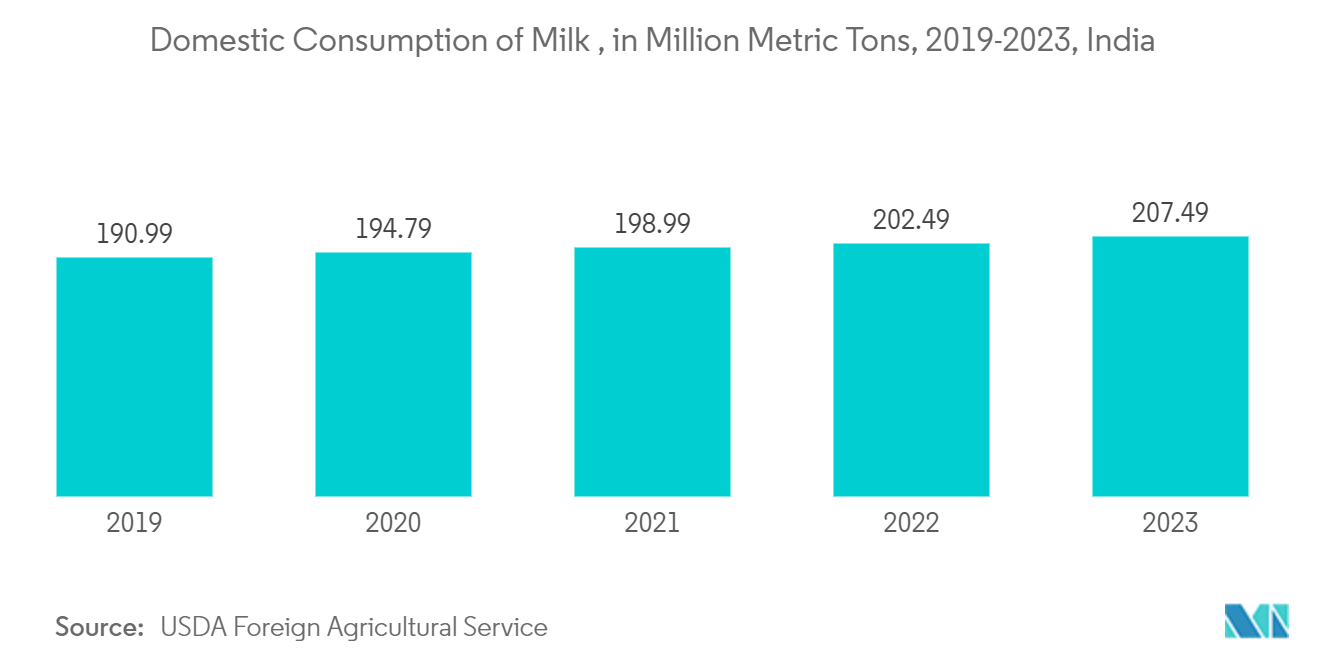
Aseptic Packaging Industry Overview
The aseptic packaging market is highly competitive and consists of several major players. With a prominent share in the market, these major players are focusing on expanding their customer bases across foreign countries. These companies leverage strategic collaborative initiatives to increase their market shares and strengthen their product capabilities through acquisitions, product launches, etc. Some of the major players in the market are Amcor Ltd, IPI SRL (Coesia Group), Tetra Pak International SA, Sealed Air Corporation, SIG Combibloc Group, and Schott AG.
- September 2023: SIG started the construction of its first aseptic carton facility in India. The plant is expected to be fully operational by 2025, and once constructed, the facility is set to support the production of up to four billion aseptic carton packs every year. With additional investments in the future, the capacity could be expanded to ten billion packs annually.
- September 2023: SIG and AnaBio Technologies joined forces to release a long-life probiotic yogurt worldwide. This collaboration introduced a novel product category, including probiotic beverages packaged in aseptic carton packs and sprouted pouches, designed to remain shelf-stable for extended storage periods without refrigeration.
Aseptic Packaging Market Leaders
Amcor Ltd.
IPI SRL (Coesia Group)
Tetra Pak International SA
Sealed Air Corporation
SIG Combibloc Group
*Disclaimer: Major Players sorted in no particular order
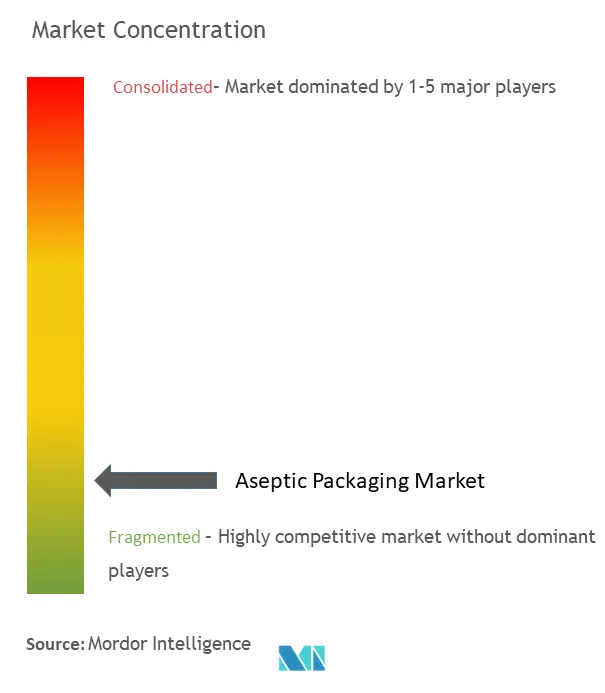
Aseptic Packaging Market News
- November 2023: Tetra Pak and Lactogal introduced a new aseptic beverage carton featuring a paper-based barrier. As a component of a substantial technology validation initiative in Portugal, encompassing around 25 million packages, this carton comprises approximately 80% paperboard and elevates the renewable content to 90%. Notably, it diminished its carbon footprint by a third (33%) and attained Carbon Neutral certification from the Carbon Trust. The company aspires to achieve industrial-scale production of the solution by 2025.
- October 2023: SIG launched SIG DomeMini, an on-the-go aseptic carton pack that combines a plastic bottle's convenience with downsizing and recyclability. The SIG DomeMini 12 Aseptic filling machine achieves aseptic filling at 12,000 packages per hour on a single machine, with the ability to change volumes in just 15 minutes. This process aims to optimize efficiency and flexibility, offering beverage manufacturers a substantial return on investment.
Aseptic Packaging Market Report - Table of Contents
1. INTRODUCTION
1.1 Study Assumptions and Market Definition
1.2 Scope of the Study
2. RESEARCH METHODOLOGY
3. EXECUTIVE SUMMARY
4. MARKET INSIGHTS
4.1 Market Overview
4.2 Industry Value Chain Analysis
4.3 Industry Attractiveness - Porter's Five Forces Analysis
4.3.1 Bargaining Power of Suppliers
4.3.2 Bargaining Power of Buyers
4.3.3 Threat of New Entrants
4.3.4 Threat of Substitute Products and Services
4.3.5 Intensity of Competitive Rivalry
4.4 Aseptic Packaging for Beverages - Demand Insights
5. MARKET DYNAMICS
5.1 Market Drivers
5.1.1 Growing Demand for Beverages
5.1.2 Commodity Value of Glass Increased With Recyclability
5.2 Market Challenges
5.2.1 Volatility in the Raw Material Prices
6. MARKET SEGMENTATION
6.1 By Product
6.1.1 Cartons
6.1.2 Bags and Pouches
6.1.3 Cans
6.1.4 Bottles
6.2 By Application
6.2.1 Beverage
6.2.1.1 Ready-to-drink Beverages
6.2.1.2 Dairy-based Beverages
6.2.2 Food
6.2.2.1 Processed Food
6.2.2.2 Fruits and Vegetables
6.2.2.3 Dairy Food
6.2.3 Pharmaceuticals
6.3 By Geography***
6.3.1 North America
6.3.1.1 United States
6.3.1.2 Canada
6.3.2 Europe
6.3.2.1 Germany
6.3.2.2 United Kingdom
6.3.2.3 France
6.3.2.4 Italy
6.3.3 Asia-Pacific
6.3.3.1 China
6.3.3.2 India
6.3.3.3 Japan
6.3.3.4 Australia and New Zealand
6.3.4 Latin America
6.3.4.1 Brazil
6.3.4.2 Argentina
6.3.5 Middle East and Africa
6.3.5.1 United Arab Emirates
6.3.5.2 Saudi Arabia
6.3.5.3 South Africa
7. COMPETITIVE LANDSCAPE
7.1 Company Profiles
7.1.1 Amcor Ltd
7.1.2 IPI SRL (Coesia Group)
7.1.3 Tetra Pak International SA
7.1.4 SIG Combibloc Group
7.1.5 DS Smith PLC
7.1.6 Uflex Limited
7.1.7 Elopak AS
7.1.8 BIBP SP ZOO
7.1.9 CDF Corporation
7.1.10 Smurfit Kappa
7.1.11 Mondi PLC
- *List Not Exhaustive
8. FUTURE OF THE MARKET
Aseptic Packaging Industry Segmentation
The report tracks consumer demand based on the sales of aseptic packaging products like cartons, bags, pouches, cans, and bottles offered by various vendors operating in the market. The report also considers the prevalent base scenarios, key themes, and end user vertical-related demand cycles.
The global aseptic packaging market is segmented by product (cartons, bags and pouches, cans, bottles, and other products), application (beverages (ready-to-drink, dairy-based beverages, and other beverages), food (processed foods, fruits and vegetables, dairy food, and other foods), pharmaceutical, and other applications) and geography (North America (the United States and Canada), Europe (Germany, United Kingdom, France, Italy, and Rest of Europe), Asia-Pacific (China, India, Japan, and Rest of Asia-Pacific), Latin America (Brazil, Argentina, and Rest of Latin America), and the Middle East and Africa (United Arab Emirates, Saudi Arabia, South Africa, and Rest of the Middle East and Africa). The market sizes and forecasts are provided in terms of value (USD) for all the above segments.
| By Product | |
| Cartons | |
| Bags and Pouches | |
| Cans | |
| Bottles |
| By Application | |||||
| |||||
| |||||
| Pharmaceuticals |
| By Geography*** | ||||||
| ||||||
| ||||||
| ||||||
| ||||||
|
Aseptic Packaging Market Research FAQs
How big is the Global Aseptic Packaging Market?
The Global Aseptic Packaging Market size is expected to reach USD 70.65 billion in 2024 and grow at a CAGR of 10.47% to reach USD 116.23 billion by 2029.
What is the current Global Aseptic Packaging Market size?
In 2024, the Global Aseptic Packaging Market size is expected to reach USD 70.65 billion.
Who are the key players in Global Aseptic Packaging Market?
Amcor Ltd., IPI SRL (Coesia Group), Tetra Pak International SA, Sealed Air Corporation and SIG Combibloc Group are the major companies operating in the Global Aseptic Packaging Market.
Which is the fastest growing region in Global Aseptic Packaging Market?
Asia Pacific is estimated to grow at the highest CAGR over the forecast period (2024-2029).
Which region has the biggest share in Global Aseptic Packaging Market?
In 2024, the Asia Pacific accounts for the largest market share in Global Aseptic Packaging Market.
What years does this Global Aseptic Packaging Market cover, and what was the market size in 2023?
In 2023, the Global Aseptic Packaging Market size was estimated at USD 63.25 billion. The report covers the Global Aseptic Packaging Market historical market size for years: 2019, 2020, 2021, 2022 and 2023. The report also forecasts the Global Aseptic Packaging Market size for years: 2024, 2025, 2026, 2027, 2028 and 2029.
Aseptic Packaging Industry Report
Statistics for the 2024 Aseptic Packaging market share, size and revenue growth rate, created by Mordor Intelligence™ Industry Reports. Aseptic Packaging analysis includes a market forecast outlook to 2029 and historical overview. Get a sample of this industry analysis as a free report PDF download.
